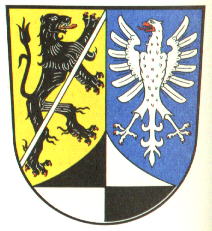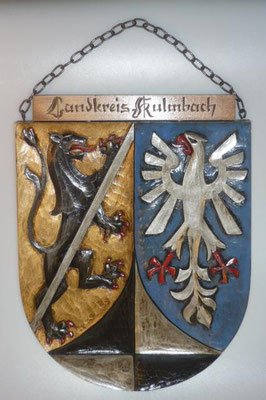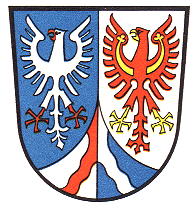Kulmbach (kreis): Difference between revisions
Knorrepoes (talk | contribs) m (Text replacement - "|center]] ====Origin/meaning====" to "|center]] ====Official blazon==== ====Origin/meaning====") |
Knorrepoes (talk | contribs) m (Text replacement - "Additions :" to "Additions:") |
||
| (29 intermediate revisions by the same user not shown) | |||
| Line 1: | Line 1: | ||
'''KULMBACH (KU)''' | '''KULMBACH (KU)''' | ||
State : [[Bayern]]<br/> | State : [[Bayern]]<br/> | ||
Additions : 1973 [[Stadtsteinach (kreis)|Stadtsteinach]] | Additions: 1973 [[Stadtsteinach (kreis)|Stadtsteinach]] | ||
[[File:kulmbac2.kreis.jpg|center]] | [[File:kulmbac2.kreis.jpg|center|alt=Wappen von {{PAGENAME}}/Arms (crest) of {{PAGENAME}}]] | ||
= | {| class="wikitable" | ||
|+Official blazon | |||
|- | |||
|'''German''' | |||
| Durch eine gesenkte, eingeschweifte, von Schwarz und Silber gevierte Spitze, gespalten von Gold und Blau; vorne ein linksgewendeter, mit einer silbernen Schräglinksleiste überdeckter, rot bewehrter schwarzer Löwe, hinten ein rot bewehrter silberner Adler | |||
|- | |||
|'''English''' | |||
| blazon wanted | |||
|} | |||
===Origin/meaning=== | |||
The arms were officially granted on August 28, 1975 | The arms were officially granted on August 28, 1975 | ||
The new arms show in the first half the arms of the State of [[Bamberg]], derived from the old arms of the Stadtsteinach district. The eagle remained from the old arms, whereas the point shows the arms of the Zollern dynasty, which also played a major role in the history of the district. | The new arms show in the first half the arms of the State of [[Bamberg]], derived from the old arms of the Stadtsteinach district. The eagle remained from the old arms, whereas the point shows the arms of the Zollern dynasty, which also played a major role in the history of the district. | ||
{|align="center" | |||
[[File: | |align="center"|[[File:{{PAGENAME}}-mus.jpg|center|Wappen von {{PAGENAME}}/Coat of arms (crest) of {{PAGENAME}}]] <br/>The arms in the [https://www.deutsches-wappen-museum.de/ Deutsches Wappenmuseum] | ||
|} | |||
The old arms were granted on March 6, 1967. | The old arms were granted on March 6, 1967. | ||
[[File:kulmbach.kreis.jpg|center|alt=Wappen von {{PAGENAME}}/Arms (crest) of {{PAGENAME}}]] | |||
The upper part of the old arms shows a white eagle, taken from the arms of both the arms of the Counts of Andechs-Meranien and the Counts of Orlamünde, and the red eagle of [[Brandenburg]]. The former two families ruled a major part of the area before and after 1248 respectively. The eagle of Brandenburg symbolises the rule of the | The upper part of the old arms shows a white eagle, taken from the arms of both the arms of the Counts of Andechs-Meranien and the Counts of Orlamünde, and the red eagle of [[Brandenburg]]. The former two families ruled a major part of the area before and after 1248 respectively. The eagle of Brandenburg symbolises the rule of the Margraves of Nürnberg and the Counts of Kulmbach-Bayreuth, who originated from the Brandenburg area. These families also played a major role in the history of the area. | ||
The lower part of the old arms shows the red and white Main rivers that flow through the area. The background colours of the lower part are taken from the arms of Bavaria and symbolise the fact that the area belongs to Bavaria since 1810. | The lower part of the old arms shows the red and white Main rivers that flow through the area. The background colours of the lower part are taken from the arms of Bavaria and symbolise the fact that the area belongs to Bavaria since 1810. | ||
{{de}} | |||
{{media}} | {{media}} | ||
[[Literature]] : Stadler,1964-1971, 8 volumes; Stadler, 1990 | [[Civic Heraldry Literature - Germany|'''Literature''']]: Stadler,1964-1971, 8 volumes; Stadler, 1990 | ||
[[Category:Kreiswappen]] | [[Category:Kreiswappen]] | ||
Latest revision as of 10:38, 28 January 2024
KULMBACH (KU)
State : Bayern
Additions: 1973 Stadtsteinach
| German | Durch eine gesenkte, eingeschweifte, von Schwarz und Silber gevierte Spitze, gespalten von Gold und Blau; vorne ein linksgewendeter, mit einer silbernen Schräglinksleiste überdeckter, rot bewehrter schwarzer Löwe, hinten ein rot bewehrter silberner Adler |
| English | blazon wanted |
Origin/meaning
The arms were officially granted on August 28, 1975
The new arms show in the first half the arms of the State of Bamberg, derived from the old arms of the Stadtsteinach district. The eagle remained from the old arms, whereas the point shows the arms of the Zollern dynasty, which also played a major role in the history of the district.
| The arms in the Deutsches Wappenmuseum |
The old arms were granted on March 6, 1967.
The upper part of the old arms shows a white eagle, taken from the arms of both the arms of the Counts of Andechs-Meranien and the Counts of Orlamünde, and the red eagle of Brandenburg. The former two families ruled a major part of the area before and after 1248 respectively. The eagle of Brandenburg symbolises the rule of the Margraves of Nürnberg and the Counts of Kulmbach-Bayreuth, who originated from the Brandenburg area. These families also played a major role in the history of the area.
The lower part of the old arms shows the red and white Main rivers that flow through the area. The background colours of the lower part are taken from the arms of Bavaria and symbolise the fact that the area belongs to Bavaria since 1810.
This page is part of the German heraldry portal Deutsche Wappensammlung |
Heraldry of the World |
|
German heraldry:
|
Selected collector's items from Germany:
|
Contact and Support
Partners:
Your logo here ?
Contact us
© since 1995, Heraldry of the World, Ralf Hartemink 
Index of the site
Literature: Stadler,1964-1971, 8 volumes; Stadler, 1990














